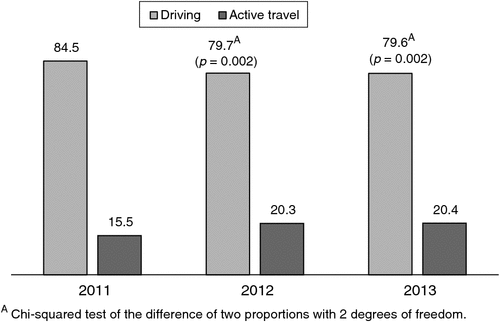We need more active travel intervention research – why not travel plans?
Nicholas Petrunoff A , Chris Rissel A C , Li Ming Wen A B and Jeni Bindon BA Prevention Research Collaboration, Sydney School of Public Health, University of Sydney, NSW 2006, Australia.
B Health Promotion Service, Sydney and South Western Sydney Local Health District, Eastern Campus, Liverpool Hospital, NSW 2170, Australia.
C Corresponding author. Email: chris.rissel@sydney.edu.au
Health Promotion Journal of Australia 25(3) 209-210 https://doi.org/10.1071/HE14051
Submitted: 15 June 2014 Accepted: 2 September 2014 Published: 4 December 2014
A high proportion of published health promotion research on physical activity is descriptive, and there is a need for more published intervention research.1,2 Although travel planning has been described as a promising way to promote population-level physical activity,3,4 a Cochrane systematic review of organisational travel plan interventions for improving health identified 17 studies, 12 of which were conducted in educational settings and 5 in workplaces.5 Evidence on the effectiveness of travel planning interventions may strengthen a case for policy that supports implementation of travel plans.
Organisational travel plans, which aim to promote active forms of transport and reduce car use, work at the individual and organisational level, and employ a mix of strategies including policy (e.g. parking management policy, public transport ticket subsidies), infrastructure (e.g. provision of end-of-trip facilities, creation of maps) and behaviour change (e.g. cycling and walking programs).
The Liverpool Hospital Travel Plan (2011–2014) is in the final stages of implementation.6 The development and baseline findings of the travel plan were the first in Australia to be published in a peer-reviewed journal,7 and the validation of the survey questions used to measure changes in travel behaviour have also been published.8 More information about the program can be found at www.activetravel.net.au.
Preliminary findings from Liverpool Hospital staff’s annual travel surveys conducted at baseline in 2011, 2012 and 2013 presented in Fig. 1, show a significant reduction in car use, and subsequent shift towards active travel.
Travel plans that are effective at decreasing car driving often include a combination of ‘carrots’ in the form of strong incentives for active travel and public transport use, as well as ‘sticks’ that are strong disincentives for car use.9,10 The Liverpool Hospital Travel Plan’s modest preliminary results may be explained by the fact that the two most effective actions have not yet been fully implemented; a public transport ticket salary deduction/sacrifice scheme has undergone only a small pilot, and the parking management plan is at the scoping study stage.
The results of surveys to date: a final survey to be conducted in September 2014 and data from a nested cohort that have been followed longitudinally will be assessed via a logistic regression model to account for potential confounding factors since the intervention lacks a control site. While the increase in active transport is modest, results are promising.

|
References
[1] Sanson-Fisher RW, Campbell EM, Htun AT, Bailey LJ, Millar CJ (2008) We are what we do: research outputs of public health. Am J Prev Med 35, 380–5.| We are what we do: research outputs of public health.Crossref | GoogleScholarGoogle Scholar |
[2] Milat AJ, Bauman AE, Redman S, Curac N (2011) Public health research outputs from efficacy to dissemination: a bibliometric analysis. BMC Public Health 11, 934
| Public health research outputs from efficacy to dissemination: a bibliometric analysis.Crossref | GoogleScholarGoogle Scholar | 22168312PubMed |
[3] Cobiac LJ, Barendregt J (2009) Cost-effectiveness of interventions to promote physical activity: a modelling study. Plos Med 6, e1000110
| Cost-effectiveness of interventions to promote physical activity: a modelling study.Crossref | GoogleScholarGoogle Scholar | 19597537PubMed |
[4] Marsden J. Associates. Evaluation of the TravelSmart Local Government and Workplace Programs 2011 [updated 27 July 2011]. Available from: http://www.transport.wa.gov.au/mediaFiles/active-transport/AT_TS_P_Evaluation_LocalGov_Workplace.pdf [Verified 20 October 2014].
[5] Hosking J, Connor J, Bullen C, Ameratunga S (2010) Organisational travel plans for improving health. Cochrane DB Syst Rev 2010, CD005575
[6] Petrunoff N, Meiklejohn D, Bindon J, Caddy A, Wen LM, Williams M, et al. Liverpool Hospital Travel Plan: 2011–2014. South-west Sydney: South Western Sydney Local Health District Health Promotion Service, 2011.
[7] Petrunoff N, Rissel C, Wen LM, Xu H, Meikeljohn D, Schembri A (2013) Developing a hospital travel plan: process and baseline findings from a western Sydney hospital. Aust Health Rev
| Developing a hospital travel plan: process and baseline findings from a western Sydney hospital.Crossref | GoogleScholarGoogle Scholar | 23701971PubMed |
[8] Petrunoff N, Xu H, Rissel C, Wen LM, van der Ploeg H (2013) Measuring workplace travel behaviour: validity and reliability of survey questions. J Environ Public Health
| Measuring workplace travel behaviour: validity and reliability of survey questions.Crossref | GoogleScholarGoogle Scholar | 23956757PubMed |
[9] Enoch M. Sustainable transport, mobility management and travel plans. Surrey, England: Ashgate Publishing Limited; 2012.
[10] Brockman R, Fox KR (2011) Physical activity by stealth? The potential health benefits of a workplace transport plan. Public Health 125, 210–6.
| Physical activity by stealth? The potential health benefits of a workplace transport plan.Crossref | GoogleScholarGoogle Scholar | 1:STN:280:DC%2BC3MvlvVSkug%3D%3D&md5=01f3f12b431f8fe544a2799913d3396cCAS | 21458011PubMed |

